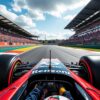In the high-octane realm of Formula 1, every race can be a defining moment. For many drivers, turning points come when least expected, reshaping their journey on the track. Liam Lawson’s recent performances have showcased this unpredictability in the most thrilling way.
After a long wait of 51 years for a points finish in Hungary, Lawson has finally hit his stride in the 2023 season. His remarkable eighth-place finish at the Hungaroring signaled a positive turn as he navigated through a challenging first half of the year. This resurgence was sparked by a notable performance at the Austrian Grand Prix, where he achieved a career-best sixth place, showcasing the power of a strategic suspension change on his Racing Bulls machine. With three points finishes in just four races, Lawson’s trajectory highlights the potency of timing and adaptability on the Formula 1 circuit.
Moreover, his consistency has marked him out as the first driver from New Zealand to score points in consecutive races since the legendary Denny Hulme, an achievement echoing across decades. Reflecting on this transformative phase, Lawson emphasizes how critical his experiences in Austria have been. Despite a rough start and some tough decisions from Red Bull, he is now finding his footing and aims to build on his recent successes. The changes may seem minor, yet they have propelled his comfort and speed on track into a new realm, marking a significant chapter in his racing career.

Liam Lawson identifies the pivotal moment when his F1 fortunes transformed after a 51-year hiatus
The landscape of Formula 1 has witnessed its fair share of extraordinary events, but few have been as noteworthy as Liam Lawson’s recent comeback. After a substantial hiatus from obtaining points, Lawson’s performance at the Austrian Grand Prix has been deemed by many as a crucial turning point in his season. The long absence of New Zealanders from the points table in Formula 1 has been palpable, with the last driver to score being the legendary Denny Hulme back in 1974. However, Lawson, with skills that can clearly be seen from the track, has emerged as a beacon of hope for his compatriots, culminating in a sequence of impressive finishes.
This transformative period began with Lawson securing a remarkable sixth-place finish at the Austrian GP—a result that not only marked his career-best but also set the stage for a surge in confidence and performance. Being the first New Zealander to score points in consecutive races since Hulme, Lawson has successfully bridged a significant gap in the nation’s F1 legacy. For many fans, this moment wasn’t just about points; it felt like a resurgence, as though a long-forsaken part of F1 history was coming alive once again.
The race in Austria also included essential changes to the Racing Bulls machine, specifically in its suspension setup. These modifications have allowed Lawson to unlock the potential of the car better, giving him the edge he needed against his teammate, Isack Hadjar. The entire configuration came together beautifully, helping Lawson navigate through a challenging stretch of the season after facing the harsh axe from Red Bull after just two races. This transformational moment can be summarized not just by mechanical tweaks but also by a player’s emotional resilience.
How did Lawson reflect on his struggles and successes after the Austrian GP?
After the monumental success at the Austrian Grand Prix, Lawson took a moment to reflect on his journey. He candidly emphasized how difficult the season had been so far. “It’s been a very tough year and hard to string a series of good results together,” he expressed during a media interview. Following his eighth-place finish at the Hungaroring, Lawson was clearly on a positive trajectory, clinching points in balance with his recent performances. The achievement marked his third points finish in just four races, demonstrating a newfound consistency that was previously elusive.
One intriguing aspect Lawson highlighted was the necessity of learning from these positive experiences—he understood that the key to accumulating more points lay in grasping what was working well and maintaining that momentum. “We just had a lot of small things in the first part of the year, and the consistency wasn’t there,” he explained. However, as those small adjustments began to yield results, there was a newfound comfort that emerged, especially since Austria. Difficulty can test one’s limits, but Lawson’s perseverance has proven beneficial as he reinvigorates his standing on the grid.
For someone who has faced challenges, especially following early setbacks in the season, Lawson emphasized the value of psychological resilience. The mind plays a critical role in Formula 1, and for someone like Lawson who is now witnessing tangible results, this emotional fortitude is something to cherish and cultivate. The learning curve was daunting but ultimately fostered growth, driving the team spirit forward.
What were the crucial changes that led to Lawson’s recent successes?
Transforming a racing season is seldom about a single breakthrough; it often involves myriad nuances that come together. As Lawson himself noted, the nuances are often “small things in the car” that set the stage for a larger impact. Changes to the suspension dynamics made the Racing Bulls more favorable for Lawson, which helped him feel more in sync with the machine. The comfort that came from these modifications provided him the confidence to push the limits that were previously restrained by underperformance.
Moreover, these changes coincided during a critical moment in Lawson’s career. The early races had been characterized by inconsistency and testing times, making the turnaround even more thrilling. The ongoing transformation illustrates that Formula 1 is not just about fast cars; the harmony between driver and machine is where magic often happens. Lawson’s adaptation to those small improvements signals how intricate the sport is, intertwining precision engineering with the driver’s skillset.
Lawson’s success has not only been technical but also acutely linked to his adaptability as a driver. Motorsport environments, especially F1, can shake confidence, which might lead younger or less experienced drivers to struggle under immense pressure. Lawson, however, embraced the nuances that the season threw at him. As he navigated through race complexities and growing expectations, he has forged a path toward a substantive comeback—able to glean insights from moments of adversity.
How has Lawson’s performance redefined expectations for New Zealand in F1?
With his recent performances, especially the eighth-place finish in Hungary, Lawson has rewritten the narrative that has long sidelined New Zealand drivers in Formula 1. His consistency in scoring points marks a significant shift, one that seems to resonate with the spirit of motorsports not only in New Zealand but around the world. This revival of interest highlights Lawson not just as another driver but a role model for aspiring racers from his homeland.
The significance of being the first Kiwi driver to score points in back-to-back races since Denny Hulme cannot be overstated. It re-establishes a legacy that had seemed lost and reignites interest in F1 from a whole new generation of fans eager to follow how an underdog can rise above challenges. Lawson’s journey carries with it the hopes and dreams of countless fans who see a reflection of their struggles and triumphs in his story—learning that resilience can indeed lead to remarkable success.
Motorsport, as we know, has a wave-like rhythm, swaying between glory days and challenging eras. For New Zealand, Lawson’s recent performance ensures that the current wave is undulating upward. This moment could catalyze support from fans who yearn to see a local hero on the global stage, reminding them that hope often lies in the unlikeliest of comebacks. The community now stands united, eager to see what comes next, evoking stories of aspiration, perseverance, and remarkable redemption.
Lawson’s journey and achievements so far offer a narrative ripe for storytelling in the F1 community—his progression reflects a deeper meaning in racing. It’s not just about crossing the finish line; it’s about how each moment shapes the narrative of a driver and a country waiting to find their place back in the sun. From challenges to triumphs, the emotional journey is what makes him a compelling figure to follow.
While pursuing the rest of the season, Lawson’s focus remains clear: he aims to sustain consistency, improve further, and perhaps set off a new chapter for New Zealand within the annals of Formula 1 history. As challenges continue to arise, the insights he gains will undoubtedly craft the template for future success, paving the way for even more exhilarating moments on and off the track.


